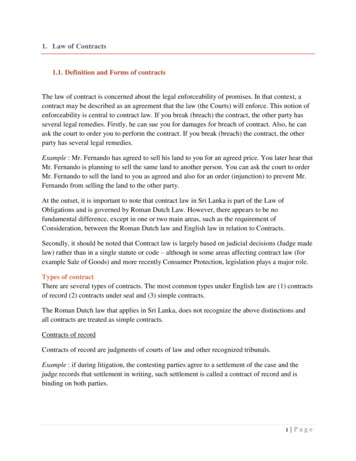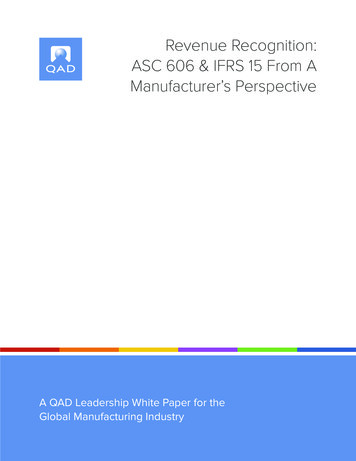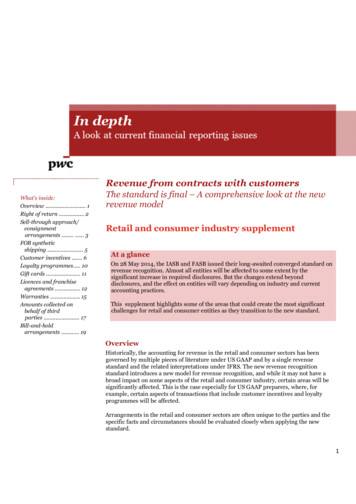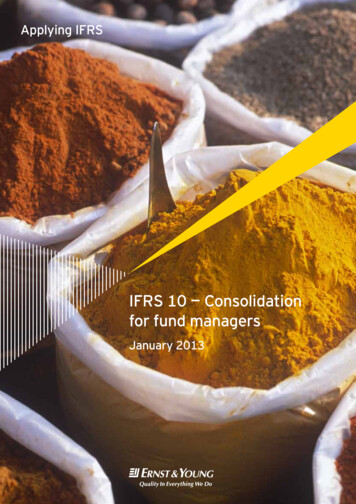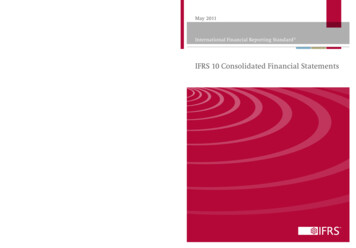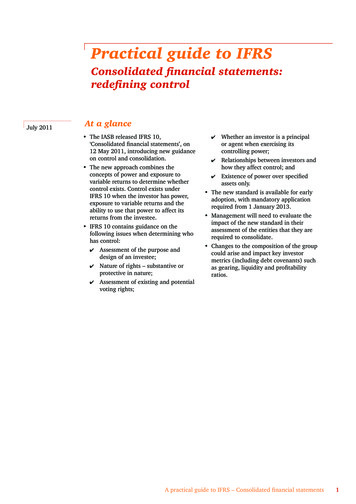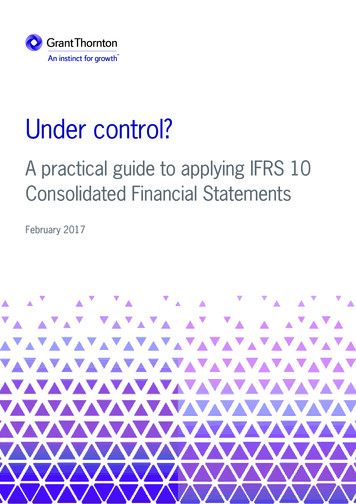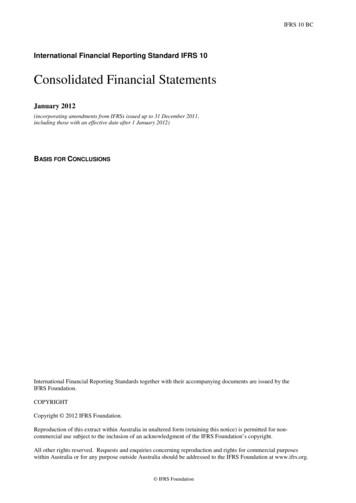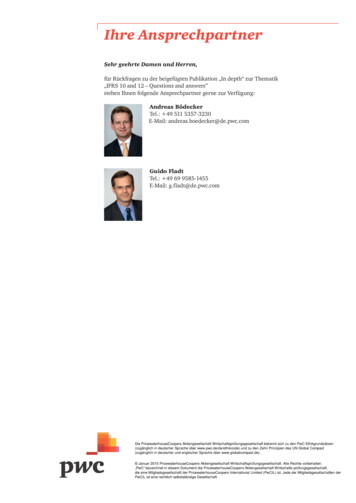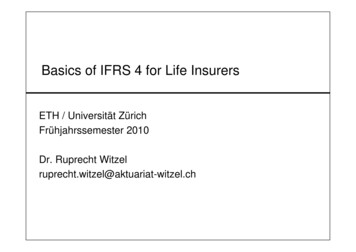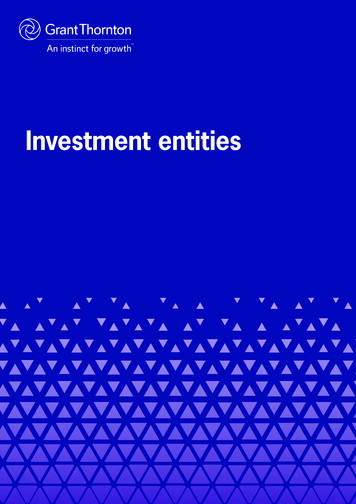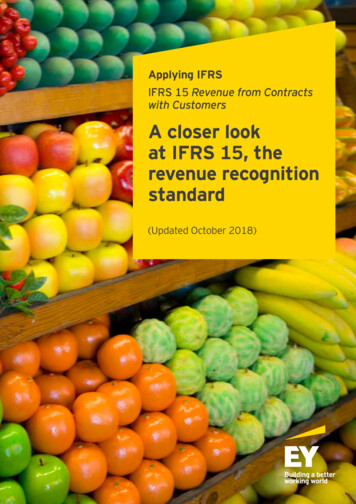
Transcription
Applying IFRSIFRS 15 Revenue from Contractswith CustomersA closer lookat IFRS 15, therevenue recognitionstandard(Updated October 2018)
OverviewMany entities have recently adopted the largely converged revenue standards,IFRS 15 Revenue from Contracts with Customers and Accounting StandardsCodification (ASC) 606, Revenue from Contracts with Customers1 (togetherwith IFRS 15, the standards), that were issued in 2014 by the InternationalAccounting Standards Board (IASB or the Board) and the US FinancialAccounting Standards Board (FASB) (collectively, the Boards). The standardssupersede virtually all legacy revenue recognition requirements in IFRS andUS GAAP, respectively.The standards provide accounting requirements for all revenue arising fromcontracts with customers. They affect all entities that enter into contracts toprovide goods or services to their customers, unless the contracts are in thescope of other IFRSs or US GAAP requirements, such as the leasing standards.The standards also specify the accounting for costs an entity incurs to obtainand fulfil a contract to provide goods or services to customers (see section 9.3)and provide a model for the measurement and recognition of gains and losseson the sale of certain non-financial assets, such as property, plant or equipment(see section 2.1.1).As a result, entities that adopted the standards often found implementation tobe a significant undertaking. This is because the standards affected entities’financial statements, business processes and internal controls over financialreporting. For entities that have not yet adopted the standards, successfulimplementation will require an assessment and a plan for managing the change.Following issuance of the standards, the Boards created the Joint TransitionResource Group for Revenue Recognition (TRG) to help them determinewhether more application guidance was needed on the standards. TRGmembers include financial statement preparers, auditors and users froma variety of industries, countries, as well as public and private entities.Members of the TRG met six times in 2014 and 2015. In January 2016,the IASB announced that it did not plan to schedule further meetings of the IFRSconstituents of the TRG, but said it would monitor any discussions of the FASBTRG, which met in April and November 2016. The November 2016 meeting wasthe last scheduled FASB TRG meeting.TRG members’ views are non-authoritative, but entities should consider them asthey implement the standards. In its July 2016 public statement, the EuropeanSecurities and Markets Authority (ESMA) encouraged issuers to considerthe TRG discussions when implementing IFRS 15.2 Furthermore, the ChiefAccountant of the US Securities and Exchange Commission (SEC) hasencouraged SEC registrants, including foreign private issuers (that may reportunder IFRS), to consult with his office if they are considering applying thestandard in a manner that differs from the discussions in which TRG membersreached general agreement.3123Throughout this publication, when we refer to the FASB’s standard, we mean ASC 606 (includingthe recent amendments), unless otherwise noted.ESMA Public Statement: Issues for consideration in implementing IFRS 15: Revenue fromContracts with Customers, issued 20 July 2016, available on ESMA's website.Speech by Wesley R. Bricker, 5 May 2016. Refer to SEC website 5-05-16.htmlUpdated October 2018A closer look at IFRS 15, the revenue recognition standard2
We have incorporated our summaries of topics on which TRG members generallyagreed at joint meetings in 2014, 2015 and at FASB-only TRG meetings in2016 throughout this publication. Unless otherwise specified, these summariesrepresent the discussions of the joint TRG. TRG members representing IFRSconstituents did not participate in the April 2016 and November 2016meetings. However, certain members of the IASB and its staff observedthe meetings and, during subsequent Board meetings, the IASB receivedoral updates. Where possible, we indicate if members of the IASB or its staffcommented on the FASB TRG discussions.This publication summarises the IASB’s standard (including all amendments)and highlights significant differences from the FASB’s standard. It alsoaddresses topics on which the members of the TRG reached general agreementand discusses our views on certain topics.While many entities have adopted the standards, implementation issuesmay continue to arise. Accordingly, the views we express in this publicationmay evolve as implementation continues and additional issues are identified.The conclusions we describe in our illustrations are also subject to changeas views evolve. Conclusions in seemingly similar situations may differ fromthose reached in the illustrations due to differences in the underlying factsand circumstances. Please see ey.com/IFRS for our most recent revenuepublications.3Updated October 2018A closer look at IFRS 15, the revenue recognition standard
ContentsOverview . 21. Objective, effective date and transition . 71.1 Overview of the standard . 71.2 Effective date . 81.3 Transition methods . 102. Scope . 392.1 Other scope considerations . 402.2 Definition of a customer. 422.3 Collaborative arrangements . 432.4 Interaction with other standards . 443. Identify the contract with the customer . 523.1 Attributes of a contract . 533.2 Contract enforceability and termination clause . 623.3 Combining contracts. 673.4 Contract modifications . 693.5 Arrangements that do not meet the definition of a contract under thestandard . 804. Identify the performance obligations in the contract. 834.1 Identifying the promised goods or services in the contract . 834.2 Determining when promises are performance obligations. 944.3 Promised goods or services that are not distinct . 1184.4 Principal versus agent considerations . 1194.5 Consignment arrangements . 1354.6 Customer options for additional goods or services . 1354.7 Sale of products with a right of return . 1495. Determine the transaction price . 1515.1 Presentation of sales (and other similar) taxes . 1535.2 Variable consideration . 1545.3 Refund liabilities . 1725.4 Rights of return . 1735.5 Significant financing component . 1785.6 Non-cash consideration . 1935.7 Consideration paid or payable to a customer. 1965.8 Non-refundable upfront fees . 2045.9 Changes in the transaction price . 2086. Allocate the transaction price to the performance obligations . 2096.1 Determining stand-alone selling prices . 2096.2 Applying the relative stand-alone selling price method . 2256.3 Allocating variable consideration . 2286.4 Allocating a discount . 233Updated October 2018A closer look at IFRS 15, the revenue recognition standard4
6.5 Changes in transaction price after contract inception . 2376.6 Allocation of transaction price to components outside the scope ofIFRS 1 . 2387. Satisfaction of performance obligations . 2407.1 Performance obligations satisfied over time . 2417.2 Control transferred at a point in time . 2757.3 Repurchase agreements . 2827.4 Consignment arrangements . 2897.5 Bill-and-hold arrangements . 2907.6 Recognising revenue for licences of intellectual property . 2947.7 Recognising revenue when a right of return exists . 2947.8 Recognising revenue for customer options for additional goods orservices . 2947.9 Breakage and prepayments for future goods or services . 2958. Licences of intellectual property . 2998.1 Identifying performance obligations in a licensing arrangement . 3008.2 Determining the nature of the entity’s promise in granting a licence . 3078.3 Transfer of control of licensed intellectual property. 3138.4 Licence renewals. 3188.5 Sales-based or usage-based royalties on licences of intellectualproperty. 3199. Other measurement and recognition topics . 3329.1 Warranties. 3329.2 Onerous contracts . 3399.3 Contract costs . 34110. Presentation and disclosure. 36710.1 Presentation requirements for contract assets and contract liabilities . 36810.2 Other presentation considerations . 37610.3 Disclosure objective and general requirements. 37710.4 Specific disclosure requirements . 37810.5 Transition disclosure requirements . 39410.6 Disclosures in interim financial statements . 395Appendix A: Extract from EY’s IFRS Disclosure Checklist . 396Appendix B: Illustrative examples included in the standard and references in thispublication . 405Appendix C: TRG discussions and references in this publication . 409Appendix D: Defined terms . 412Appendix E: Changes to the standard since issuance. 413Appendix F: Summary of important changes to this publication . 414Appendix G: Summary of differences from US GAAP . 4215Updated October 2018A closer look at IFRS 15, the revenue recognition standard
What you need to know IFRS 15 creates a single source of revenue requirements for all entitiesin all industries. It represents a significant change from legacy IFRS. IFRS 15 applies to revenue from contracts with customers and replacedall of the legacy revenue standards and interpretations in IFRS, includingIAS 11 Construction Contracts, IAS 18 Revenue, IFRIC 13 CustomerLoyalty Programmes, IFRIC 15 Agreements for the Construction of RealEstate, IFRIC 18 Transfers of Assets from Customers and SIC-31 Revenue– Barter Transaction involving Advertising Services. IFRS 15 is principles-based, consistent with legacy revenue requirements,but provides more application guidance. The lack of bright lines requiresincreased judgement. The standard may have had little effect on some entities, but may requiresignificant changes for others, especially those entities for which legacyIFRS provided little application guidance. IFRS 15 also specifies the accounting treatment for certain items nottypically thought of as revenue, such as certain costs associated withobtaining and fulfilling a contract and the sale of certain non-financialassets.Updated October 2018A closer look at IFRS 15, the revenue recognition standard6
1. Objective, effective date and transition1.1 Overview of the standardThe revenue standards the Boards issued in May 2014 were largely converged.IFRS 15 and the FASB’s standard supersede virtually all legacy revenuerecognition requirements in IFRS and US GAAP, respectively. Noting severalconcerns with previous requirements for revenue recognition under both IFRSand US GAAP, the Boards’ goal in joint deliberations was to develop revenuestandards that:4 Remove inconsistencies and weaknesses in the legacy revenue recognitionliterature Provide a more robust framework for addressing revenue recognition issues Improve comparability of revenue recognition practices across industries,entities within those industries, jurisdictions and capital markets Reduce the complexity of applying revenue recognition requirements byreducing the volume of the relevant standards and interpretations Provide more useful information to users through expanded disclosurerequirementsThe standards provide accounting requirements for all revenue arising fromcontracts with customers. They affect all entities that enter into contracts toprovide goods or services to their customers, unless the contracts are in thescope of other IFRSs or US GAAP requirements, such as the leasing standards.The standards also specify the accounting for costs an entity incurs to obtainand fulfil a contract to provide goods or services to customers (see section 9.3)and provide a model for the measurement and recognition of gains and losseson the sale of certain non-financial assets, such as property, plant or equipment(see section 2.1.1).IFRS 15 replaces all of the legacy revenue standards and interpretationsin IFRS, including IAS 11 Construction Contracts, IAS 18 Revenue,IFRIC 13 Customer Loyalty Programmes, IFRIC 15 Agreements for theConstruction of Real Estate, IFRIC 18 Transfers of Assets from Customersand SIC-31 Revenue – Barter Transactions Involving Advertising Services.5When they were issued in 2014, the standards were converged, except fora handful of differences.6 Since then, the Boards have issued some convergedamendments to their standards, but they have also issued different amendmentsto the same topics (see Appendix E for a discussion of the changes to thestandards since issuance). The FASB has also issued several amendments thatthe IASB has not issued. We highlight the significant differences between theIASB’s final standard and the FASB’s final standard throughout this publication.However, the primary purpose of this publication is to highlight the IASB’s4567IFRS 15.IN5.IFRS 15.IN3, C10.As originally issued, the standards under IFRS and US GAAP were identical except for these areas:(1) the Boards used the term ‘probable’ to describe the level of confidence needed whenassessing collectability to identify contracts with customers, which will result in a higherthreshold under US GAAP than under IFRS; (2) the FASB required more interim disclosures thanthe IASB; (3) the IASB allowed early adoption and the FASB did not; (4) the IASB allowedreversals of impairment losses and the FASB did not; and (5) the FASB provided relief for nonpublic entities relating to specific disclosure requirements and the effective date.Updated October 2018A closer look at IFRS 15, the revenue recognition standard
standard, including all amendments to date, and focus on the effects forIFRS preparers.7 As such, we generally refer to the singular ‘standard’.1.1.1 Core principle of the standardThe standard describes the principles an entity must apply to measure andrecognise revenue and the related cash flows. The core principle is that anentity recognise revenue at an amount that reflects the consideration towhich the entity expects to be entitled in exchange for transferring goodsor services to a customer.The principles in IFRS 15 are applied using the following five steps:1. Identify the contract(s) with a customer2. Identify the performance obligations in the contract3. Determine the transaction price4. Allocate the transaction price to the performance obligations in thecontract5. Recognise revenue when (or as) the entity satisfies a performanceobligationEntities need to exercise judgement when considering the terms ofthe contract(s) and all of the facts and circumstances, including impliedcontract terms. Entities also have to apply the requirements of thestandard consistently to contracts with similar characteristics and in similarcircumstances. To assist entities, IFRS 15 includes detailed applicationguidance. The IASB also included more than 60 illustrative examples in IFRS 15.We included a list of these examples in Appendix B to this publication andprovided references to where certain examples are included in this publication.1.2 Effective dateIFRS 15 became effective for annual reporting periods beginning on or after1 January 2018. Early adoption was permitted, provided that fact wasdisclosed.7For more information on the effect of the new revenue standard for US GAAP preparers,refer to our Financial Reporting Developments: Revenue from contracts with customers(ASC 606), Revised April 2017, available on EY AccountingLink.Updated October 2018A closer look at IFRS 15, the revenue recognition standard8
The table below illustrates the effective date of IFRS 15 for entities withdiffering year-ends and assumes that entities report results twice a year (annualand half-year).Year-endMandatoryadoptionEarly adoption31 December1 January 2018adoption date.Present for the firsttime in 30 June2018 interimfinancial statementsand in31 December 2018annual financialstatements.Possible adoption date
The revenue standards the Boards issued in May 2014 were largely converged. IFRS 15 and the FASB’s standard supersede virtually all legacy revenue recognition requirements in IFRS and US GAAP, respectiv
